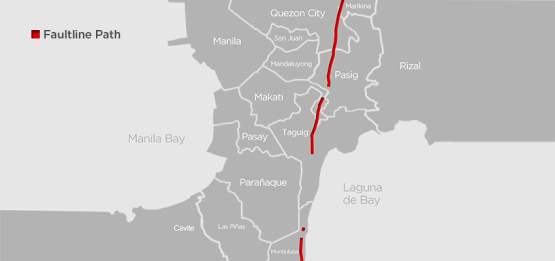Fresh from the onslaught of the flooding brought about by the heavy monsoon, the city of Mandaluyong on September 29 was hit by a 2.7-magnitude earthquake. The Philippine Institute of Volcanology and Seismology said on Twitter that Antipolo, Quezon City, and Manila were also affected by the earthquake.
Although the effects of the earthquake were mild, one could not help but think whether the tremor was a sign of something bigger. To put into things into perspective, all of the affected cities are classified as densely-packed, highly urbanized cities based on 2010 Philippine Census data, with each city having a population of more than 300,000. Should Mandaluyong or any other area within the Marikina Valley Fault System experienced a more stronger earthquake that day, we are looking at a possible national disaster.
On the other hand, there is still a lot to be learned about earthquakes. We have gathered the top ten popular urban myths about earthquakes in Metro Manila and attempt to expose the truth behind them.
Myth 1: ”Earthquakes occur during ‘earthquake weather.’ Big ones happen early in the morning.”
The truth: An earthquake can happen any time of the day, regardless of the weather.
Government experts have already said that there is no such thing as “earthquake weather.” Moreover, there are at least a couple of strong earthquakes in the Philippines that did not happen in the morning. ABS-CBN reported that the 2012 Visayas earthquake that shook Negros Oriental and Cebu happened minutes before lunchtime. The 1990 Luzon earthquake, which was one of the strongest in the country so far at a surface-wave magnitude of 7.8, occurred at 4:26PM and caused destruction in Baguio, Cabanatuan, Dagupan, and La Union.
Myth 2: ”Small earthquakes are a good thing as they prevent larger earthquakes from happening.”
The truth: Small earthquakes do not prevent a large earthquake from happening, nor reduce the impact of an incoming stronger tremor.
US Geological Survey seismologist and American Geophysical Union fellow Susan Hough said in her piece for the Washington Post this is because of the fact that a strong earthquake requires a significant amount of energy coming from the ground given off at that single moment. As such, the energy given off by smaller earthquakes is from the ground given off at a separate instance and is not coming from a larger tremor.
Myth 3: “An earthquake fault can swallow buildings and people, just like in that ‘2012’ movie.”
The truth: The “2012” movie is just a movie.
You would have to blame pop culture for this belief. In the movie “2012,” we saw John Cusack do the impossible as he drove his estranged family through the shifting streets of Los Angeles that were caused by a series of strong earthquakes. Cusack and his group are shown later in the scene on a small airplane looking back at the remains of the city, which had parts swallowed up by faults.
USGS insisted that this notion is false for the simple reason that the ground usually moves across a fault. If a fault would open, it means that there is no longer an earthquake because there is no more ground friction. Friction is needed in order for an earthquake to occur. USGS said shallow cracks could form during an earthquake that could induce ground failures like landslides.
Myth 4: ”Animals have a ‘sixth sense’ in detecting earthquakes.”
The truth: Your pet dog or cat can sense danger, but could be just as clueless as you about an incoming earthquake.
Freelance geologist David Bressan said in his blog post on the Scientific American that there is no doubt that animals react to any change in their environment. Although animals do not have a particular sense to detect natural calamities like an earthquake, Bressan believe that animals are more attuned to their environment, and their heightened senses that are initially designed to protect them from enemies may have also been used to warn them of imminent environmental threat. However, USGS recommends not using your pet dog or cat as an early-warning device against earthquakes.
Myth 5: “In case of an earthquake, find a ‘Triangle of Life’ near you to protect yourself.”
The truth: The ‘Drop, Cover, and Hold On’ method is more widely endorsed by authorities than the ‘Triangle of Life’.
Doug Copp’s theory dictates that in order to survive, you would have to hide near a tall object like a wall or a cubicle partition. Copp argued that much of the weight of the ceiling will be carried by the tall object and the ceiling will end up like a sloped roof over you.
Marguerite de Leon of Rappler reported that many reputable agencies and websites have refuted the self-proclaimed rescue expert’s supposedly life-saving theory. She also noted that even the author’s experience in rescue and recovery work, especially in the aftermath of the World Trade Center attacks, has been challenged in an investigation by the US Department of Justice. It is unclear whether the federal investigation on Copp has been resolved. Meanwhile, Copp is still actively promoting his theory in the US, Peru and Taiwan, according to the updates on his website.
Myth 6: “When indoors during an earthquake, it is safer to hide under a doorway.”
The truth: Staying put and taking cover under a sturdy object is still the best way to minimize the impact of a collision due to an earthquake.
Google this myth and you’ll find many articles and blog posts debunking this theory. Lifehacker said that when caught indoors during an earthquake, hiding under a sturdy desk and staying put is the best way to protect yourself. If you are in bed, covering your head with pillows and holding on to the bedframe is suggested as well.
Myth 7: ”A 7.2 earthquake could bring about the destruction of Metro Manila.”
The truth: Confirmed. However, there is no exact timeframe as to when an earthquake of this magnitude could happen.

Phivolcs director Renato Solidum recently announced that Metro Manila could get isolated if it gets hit with a 7.2-magnitude earthquake. According to him, a movement in the West Valley Fault, could split Manila into four regions and cause heavy damage to over 100,000 buildings, especially those in Makati, Mandaluyong, and areas near the Pasig River.
Regional Coordinator for Disaster Reduction Jerry Velasquez of the United Nations Environment Programme clarified that the likelihood of a strong earthquake destroying Metro Manila could not be foreseen in a specific period of time. This means that although a strong earthquake similar to the one in Japan is bound to happen, there is no way for anyone in the world to predict when an earthquake would occur.
Myth 8: “Areas inside the West Valley Fault are unlivable.”
The truth: The urban and residential areas located near the fault have complied with government requirements to ensure their safety against stronger earthquakes.
The West Valley Fault Line begins from Sierra Madre and goes through Bulacan, Rodriguez, Rizal, Quezon City down to the eastern side of Metro Manila including Pasig, Taguig, Muntinlupa, San Pedro, and Sta. Rosa in Laguna, where major business and residential development are located. Phivolcs deputy administrator Bartolome Bautista was quoted as saying that the fault line moves every 200 to 400 years, and that another major movement is anticipated.
And just like any other urban community located near a fault line like New York (Clarendon-Linden fault system, Ramapo Fault), California (San Andreas Fault) and San Francisco (Hayward Fault Zone), for example, building codes and disaster mitigation programs have been catered to address situations of a major earthquake.
Solidum said that the National Building Code of the Philippines has always provided property developers a guideline in building properties especially near the fault line. Moreover, he said that developers are now required to secure permission from their agency before the construction of their projects. Also, developers are not allowed to build properties within the five-meter buffer zone on both sides of the fault line.
Myth 9: “Tall buildings are the most unsafe places in Manila in case of an earthquake.”
The truth: You are more likely safe in a tall building when you remain in a spot and protect yourself from moving or falling objects or people rushing to leave the building.
Jack Pappin for UK-based project management and design firm ARUP said that tall buildings nowadays are built to be safe from smaller seismic shocks at least. This is because tall buildings take into account the lateral loads produced by the winds that are usually higher than the tremors from an earthquake.
In his response about the safety of the tall buildings and urban centers in Metro Manila, National Disaster Risk Reduction and Management Council (NDRRMC) executive officer Benito Ramos claimed,
Our high-rise residential areas and offices are safer than the old post-World War II buildings that we have. These new structures are designed to withstand a seven magnitude quake.
Myth 10: ”Metro Manila is not ready for a Japan-like earthquake.”
The truth: No one can be ready for an earthquake. But we can prepare ahead for a disaster.
When asked about the NDRMMC’s capability in handling disaster relief operations if a higher-magnitude earthquake hits Metro Manila, Ramos said,
“I can say we are prepared. Up to what level, that I cannot say. You cannot fight the wrath of nature, but you can always mitigate its impact.”
The NDRMMC has ramp up hosting nationwide earthquake drills, capability-building training and disaster seminars. Ramos shared that Metropolitan Manila Development Authority (MMDA) for one, has already positioned disaster rescue equipment in key locations in the Metro Manila and the National Capital Region.
Do you know about other popular or urban earthquake myths? We’d love to hear them! Share them by leaving a comment below.











